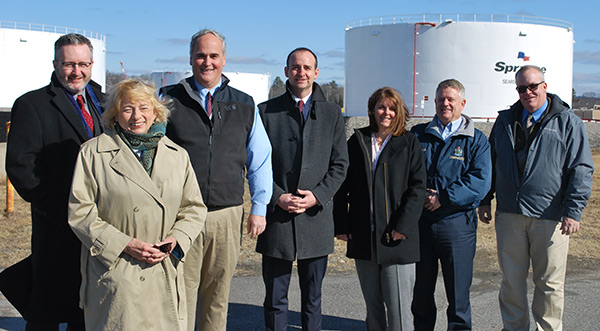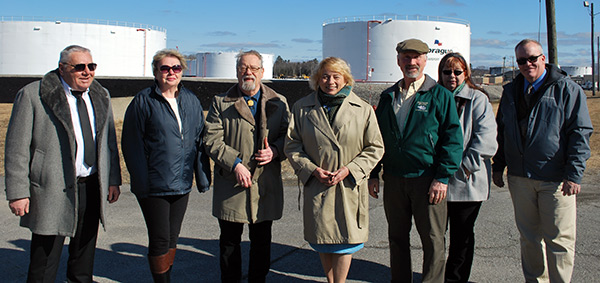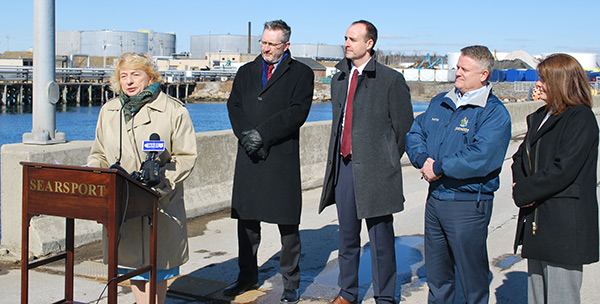Searsport, MAINE – Standing at the pier of Mack Port Terminal, Governor Janet Mills announced today that her Administration will examine the site for opportunities to support Maine’s renewable energy industry, specifically offshore wind. The announcement follows Governor Mills’ visit to Scotland last week as a member of a U.S. state and federal delegation organized by the United Kingdom government to learn more about offshore wind. It also follows her State of the State address in which she spoke of unleashing Maine’s offshore wind potential.

“Offshore wind is poised to become a $1 trillion industry by 2040, creating thousands of good-paying jobs, providing clean renewable energy, and spurring economic growth. With our existing port infrastructure and proximity to both European and east coast markets, Maine is well-positioned to become a leader in the offshore wind industry just as Scotland has,” said Governor Mills. “Searsport has been critical for the delivery and deployment of onshore wind in New England for years. My Administration will evaluate how the Port can do the same for offshore wind. I look forward to the results of this assessment and charting a path forward for this industry in Maine.”
The assessment, called the Port Infrastructure and Market Potential Assessment, will be led by the Maine Department of Transportation (Maine DOT), the Governor’s Energy Office, and the Department of Economic and Community Development as a part of the Maine Offshore Wind Initiative. It will utilize the 2017 Searsport Intermodal Commodity Study as a foundation and identify and assess short-term and long-term port opportunities related to the offshore wind industry. It will, at a minimum, review current site characteristics, provide an analysis of potential port users and identify structural improvements or capital investments that may be needed. Additional analysis and review will also be undertaken to review offshore wind supply chain opportunities such as foundation and turbine assembly as well as the workforce needed to support these activities in Maine.

In addition, Aqua Ventus, the project slated to be the first floating offshore wind project in the country, is also planning for approval to use the Port to assemble the hull that will be towed out to the demonstration test site off Monhegan Island. In June of 2019, Governor Mills signed into law LD 994, a Resolve sponsored by Republican Senator David Woodsome, directing the Maine PUC to approve the contract for Aqua Ventus, which was done in late 2019. The University of Maine has estimated that Aqua Ventus will produce nearly $152 million in total economic output, and more than 553 Maine-based direct jobs during the construction period, including jobs for design and construction. Operations and maintenance of the facility will create an additional direct economic output of approximately $16 million over 20 years.
Prior to the announcement, Governor Mills toured Mack Point Terminal and viewed onshore wind turbine components that have been delivered to the terminal for the Weaver Wind onshore project in Hancock County.
An active seaport since the 1700s, Searsport is Maine’s second largest seaport and is home to an intermodal port facility serving coastal and inland areas of Maine. The Mack Point terminal is currently able to handle a diverse array of product including bulk shipments as well as project and containerized cargo. The terminal currently has space for laydown, bulk piling, warehousing and liquid tank storage as well as a potential for further development on existing property. Sprague Operating Resources, LLC operates Mack Point and owns the liquid bulk pier, while the Maine Port Authority owns the dry bulk pier, which Sprague operates. The Maine Port Authority and MaineDOT recently invested in a new heavy bulk cargo handling equipment at the port. In addition, MaineDOT over the last two years has made investments in upgrading the connecting rail infrastructure at the port.
“Onshore wind development has provided a great boost to Maine's economy. Hundreds of Maine construction workers have been kept employed by this industry for many years,” said Representative Scott Cuddy. “The oncoming development of offshore wind is an exciting time for Maine and an exciting time for Searsport. Maine is poised to be an industry leader, and Searsport is perfectly situated to help make that happen!”
“The town of Searsport is excited and pleased to see progress in the development of offshore wind out of our Port,” said Searsport Town Manager, James Gillway. “We have been closely connected to the ocean since our inception in 1845. We thank the Governor for moving this industry forward as clean, renewable energy is vitally important to our community and state.

"The port facility in Searsport is playing an integral part in the logistics of bringing in the components to construct the Weaver wind project, as it has on previous wind power projects we’ve developed in Maine,” said Paul Gaynor, chief executive officer of Longroad Energy. "Over the last decade, wind investment in Maine has crossed the $2 billion mark – the Searsport terminal and many other Maine businesses have benefited from this influx of capital; importantly, it allows our investment to directly benefit Maine people and Maine industry."
Over the past year, Maine has made significant progress in moving forward renewable energy and offshore wind, including lifting the wind moratorium, passing legislation requiring the PUC to approve the contract for Maine Aqua Ventus, which will be the first floating offshore wind project in the country, and joining with New Hampshire and Massachusetts on the federal Gulf of Maine Renewable Energy Task Force to examine opportunities for offshore wind. The Task Force, led by the federal government, seeks to identify potential opportunities for renewable energy leasing and development sites in federal waters off the coast of Maine.
As a part of the Maine Offshore Wind Initiative, the state will also soon be launching an initiative to engage directly with the commercial fishing industry to facilitate communication and solicit input to ensure any potential development considers the fishing industry and other maritime interests.